Fire Services
Routine Inspection & Servicing Maintenance & Repairs
- Automatic Fire Detection And Alarm Systems
- Emergency Warning And Communication Systems
- Fire Doors
- Fire Dampers, Seals And Shutters
- Smoke Detection
- Automatic Sprinkler System
- Hydrants And Hose Reels
- Pump Systems
- Emergency Lighting And Exit Signs
- Portable Fire Extinguishers
- Inspection Bookings Online By Tenants Using Qr-code (Calendly)
- Easy To Read Reports And Quotes With Photos Using Our Software Uptick
Equipment & Test Frequency
- Fire indicating panels – Monthly, 6 Monthly & Annually
- Smoke & heat detectors– 6 Monthly & Annually
- Fire sprinkler systems – Weekly or Monthly, Annually, 3 yearly, 24 yearly
- Evacuation system – Monthly, 6 Monthly & Annually
- Fire alarm system – Monthly & Annually
- Fire hydrant – 6 Monthly & Annually
- Hose reel systems – 6 Monthly & Annually
- Fire booster pumps – Monthly & 6 monthly & Annually
- Fire extinguishers – 6 Monthly & Annually
- Emergency Lighting – 6 Monthly & Annually
- Fire doors – Quarterly or 6 monthly, annually
- Gas suppression systems – 6 Monthly & Annually
- Water mist systems – 6 Monthly & Annually
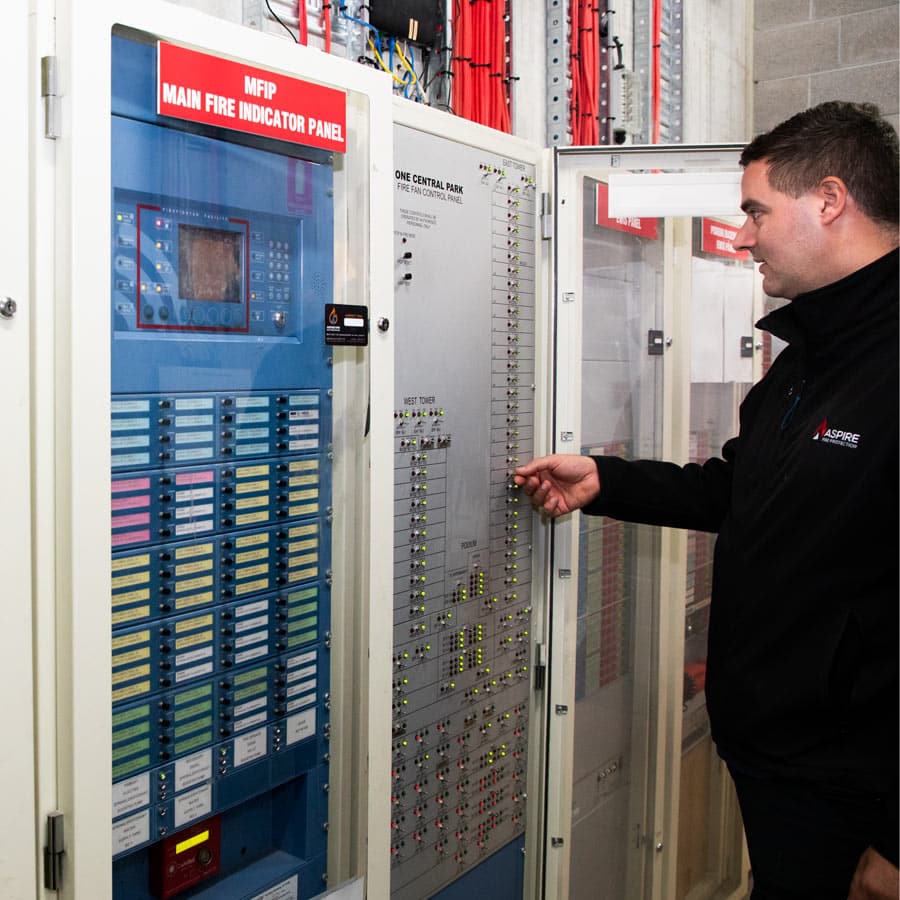
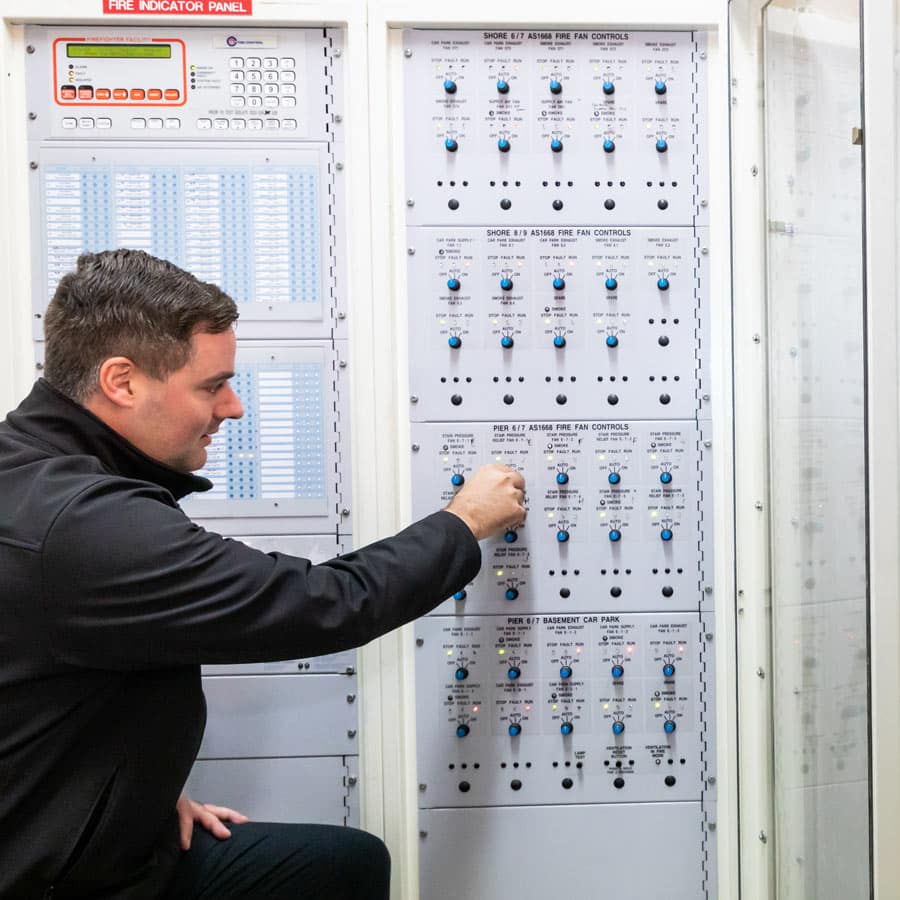
Aspirating Smoke Detector (ASD)
Aspirating Smoke Detector (ASD), an early warning aspirating smoke detection solutions with continuous air sampling, provide the earliest possible warning of an impending fire hazard, while eliminating the cost of nuisance alarms.
ASD-aspirating smoke detectors buy the critical time needed to investigate an alarm and initiate an appropriate response.
Conventional smoke detection does not offer the best protection because toxic smoke can begin to spread, and fire damage can occur before a warning is issued. In contrast, ASD actively sample the air for even the smallest particles of smoke to detect a fire at the earliest stage.
ASD detectors have multi-level warnings and a wide range of sensitivity that does not degrade or change over time, so even minute levels of smoke can be detected before a fire has time to escalate.
Sprinklers
Sprinklers are simple devices that are individually operated by the heat from a fire.
When a fire starts hot gases rise to the ceiling. If a sprinkler is present, a glass bulb or solder link gets hot and at a specific temperature (typically 68°C) breaks, releasing a cap and allowing water to flow onto a diffuser.
The diffuser breaks up the water flow into carefully controlled droplets which penetrate the fire plume and cool the burning material to below its ignition point, thus controlling the fire. Only the sprinkler(s) directly over the fire are operated.
The sprinklers are connected to pipework, usually filled with water, supplied either from the water mains or a storage tank via a pump. When a sprinkler operates, the flow of water in the pipework operates a flow switch which in turn operates an alarm system.
At Aspire Fire we design, install and service sprinkler systems using the latest design and installation techniques including water supplies (pumps and tanks), underground or aboveground hydrant mains, fire hydrants, hose reels and associated equipment and cabinets.
Hydrant & Hose Reels Installation Process
SURVEY
The first step of creating a Fire Hydrant and Hose Reel System is to do a complete site survey to see what is needed, we can then fully meet all your requirements and make sure you are fully protected.
DESIGN & INSTALLATION
We firstly design the system to make sure all aspects are taken into account. Once this is agreed upon we will install the system with minimum disruption to you. We fully test each system to make sure it’s in full working order before we finish.
MAINTENANCE
Once your Sprinkler or Hydrant Pump System has been installed we offer maintenance contracts which will keep your system in full working order if it is called upon. This is an extremely important part as your sprinkler or hydrant system needs to work when you need it the most.
Think of an annual pump test as mirroring what could happen if the apparatus were called to a multiple-alarm fire where water in maximum volumes and pressures had to be moved for more than an hour. A multiple-alarm fire is no place to test the pump. However, the test pit is.
Your Sprinkler or Hydrant Pump System requires testing monthly, six monthly, annually and five yearly in accordance with AS1851-2012.
Upon completion of Sprinkler or Hydrant Pump System inspections, a report is produced detailing the condition of the system and listing the areas of any non-compliance, which creates a database and asset register for future on-going inspections.
24 HOUR MAINTENANCE AND FAST RESPONSE
Assured all your concerns or issues will be dealt with as we provide a 24 hour callout facility with all service contracts.
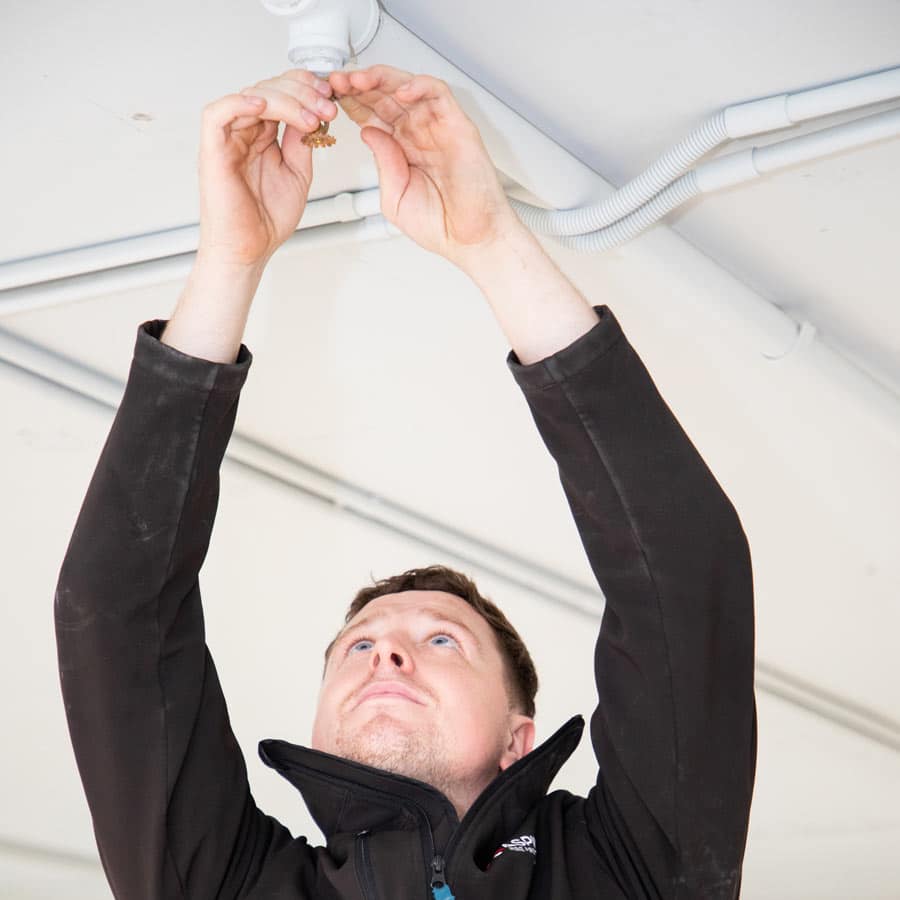
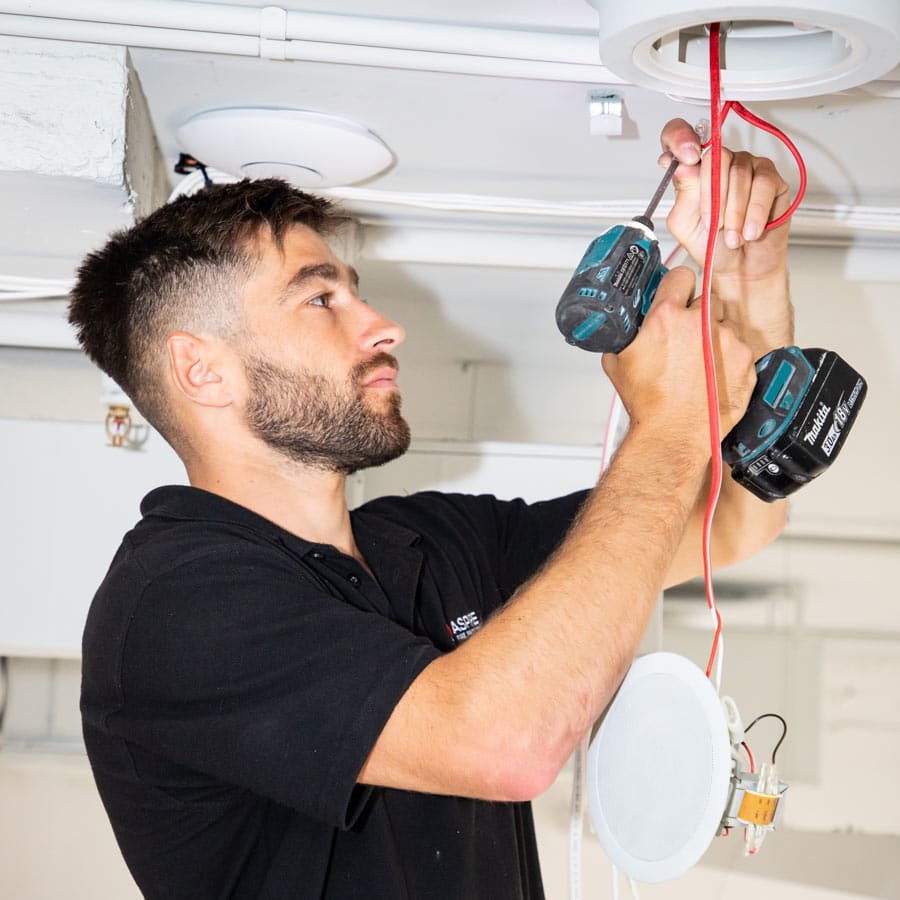
Fire Alarms
Modern Systems Go Well Beyond Simply Sounding An Alarm.
Our installations can tell you how much fire there is and where it originates from, or can sample the air for the faintest scent of smoke from even a smouldering fire with no flame. A reliable fire detection system will save lives and minimise costly damage to your buildings and property.
All buildings whether publicly or privately owned have a legal requirement for a minimum level of fire protection. Here at Aspire Fire we can ensure that you have the necessary level of protection to fulfil these requirements. There is a broader than ever range of cost-effective solutions to choose from in order to suit the needs of your business.
Fire Alarm Installation Process
SURVEY
The first step of creating a Fire Alarm System is to do a complete site survey to see what is needed, we can then fully meet all your requirements and make sure you are fully protected.
DESIGN & INSTALLATION
We firstly design the system to make sure all aspects are taken into account. Once this is agreed upon we will install the system with minimum disruption to you. We fully test each system to make sure it’s in full working order before we finish.
MAINTENANCE
Once your Fire Alarm System has been installed we offer maintenance contracts which will keep your system in full working order if it is called upon. This is an extremely important part as your fire alarm needs to work when you need it the most.
Your Fire Alarm system requires testing monthly, six monthly, annually and five yearly in accordance with AS1851-2012.
Upon completion of fire alarm inspections, a report is produced detailing the condition of the system and listing the areas of any non-compliance, which creates a database and asset register for future on-going inspections.
24 HOUR MAINTENANCE AND FAST RESPONSE
Assured all your concerns or issues will be dealt with as we provide a 24 hour callout facility with all service contracts.
Types of Fire Alarms
CONVENTIONAL FIRE ALARM SYSTEMS
The hardware associated with a conventional fire alarm tends to be much cheaper than the other types of alarm, however they are more difficult to install because they require more wiring, which in turn means more time is needed from installation team.
A conventional system won’t be able to tell you the precise location of the fire, however if they are wired correctly they will be able to divide your premises into zones.
This means they can still be used as a cheaper solution even in premises with multiple floors or areas as long as the arrangement is fairly simple. However we wouldn’t recommend them for more complex buildings.
ADDRESSABLE FIRE ALARM SYSTEMS
Addressable Alarm Systems are a little more sophisticated than the more basic conventional type. Every device connected to the addressable system has its own unique address – hence the name.
This means that when a fire is detected, the fire alarm control panel is able to tell you exactly which device has been activated, whether it’s a detector or a call point. This in turn means you have more chance of locating the fire and putting it out quickly.
Whilst addressable systems cost a little more, they can be easier to install than conventional systems because all of the devices are connected to one, wire ‘loop’, rather than by individual cables.
They also have the potential to save your business money over time as they are less prone to false alarms and more effective in the case of actual fire. They are definitely worth considering for any commercial building that is a little more complex.
WIRELESS FIRE ALARM SYSTEMS
Wireless Fire Alarm Systems are great for premises that need to take appearances into account, such as high-end retail outlets, or who are restricted from doing much with the property, such as heritage buildings.
As the name suggests, they require no cabling so are very quick and simple to install. However the systems themselves are expensive and have a number of ongoing costs associated with them.
Primarily this ongoing cost is the regular replacement of batteries. These need to be frequently checked and replaced if necessary. Some wireless systems use bespoke batteries which are more expensive than the standard types you’re used to buying in the shops.
Because of the ongoing cost, we would recommend wireless systems in specialist cases as mentioned above, or as a temporary fire safety solution where it’s not feasible to install a wired system, such as on building sites.
OTHER TYPES OF FIRE ALARM SYSTEM
Outside of the three main types of Fire Alarm System, there are many variations of detector, call point and warning systems.
As well as installing systems Aspire Fire also offers a range of fire alarm maintenance packages.
A maintenance support package not only ensures you have access to immediate support in the event of a system malfunction, it will also help with compliance record keeping and avoid emergency call costs.
Any project starts with a Fire Risk Assessment, this involves a comprehensive assessment of the site and buildings. Based on the results of the assessment we can then design, install or repair any equipment as necessary to ensure new and existing buildings comply with Australian Fire Regulations and maintain structural fire integrity.
Once your system is in place, periodic maintenance checks and a fast response to repair needs will ensure it operates with maximum efficiency.
- We can offer a full range of fire alarm systems from simple conventional panels to highly sophisticated addressable systems
- We have a comprehensive understanding of the Standards in Australia and can offer advice to our clients as to what is required to make a system compliant
- We represent a range of manufacturers and are happy to take over the maintenance and testing of both new and existing installations
Fire Pumps
Your sprinkler system is your automatic line of defence to suppress a fire – as long as your pumps are working.
Typically, over the lifetime of a pump, twice as much is spent on maintenance and repair as on the initial purchase.
It is important to budget for maintaining your pumps.
Effective preventive maintenance can not only make cost savings, but it will also save considerable time and hassle.
Fire Pumps Installation Process
SURVEY
The first step of creating a Sprinkler or Hydrant Pump System is to do a complete site survey to see what is needed, we can then fully meet all your requirements and make sure you are fully protected.
DESIGN & INSTALLATION
We firstly design the system to make sure all aspects are taken into account. Once this is agreed upon we will install the system with minimum disruption to you. We fully test each system to make sure it’s in full working order before we finish.
MAINTENANCE
Once your Sprinkler or Hydrant Pump System has been installed we offer maintenance contracts which will keep your system in full working order if it is called upon. This is an extremely important part as your sprinkler or hydrant system needs to work when you need it the most.
Think of an annual pump test as mirroring what could happen if the apparatus were called to a multiple-alarm fire where water in maximum volumes and pressures had to be moved for more than an hour. A multiple-alarm fire is no place to test the pump. However, the test pit is.
Your Sprinkler or Hydrant Pump System requires testing monthly, six monthly, annually and five yearly in accordance with AS1851-2012.
Upon completion of Sprinkler or Hydrant Pump System inspections, a report is produced detailing the condition of the system and listing the areas of any non-compliance, which creates a database and asset register for future on-going inspections.
24 HOUR MAINTENANCE AND FAST RESPONSE
Assured all your concerns or issues will be dealt with as we provide a 24 hour callout facility with all service contracts.
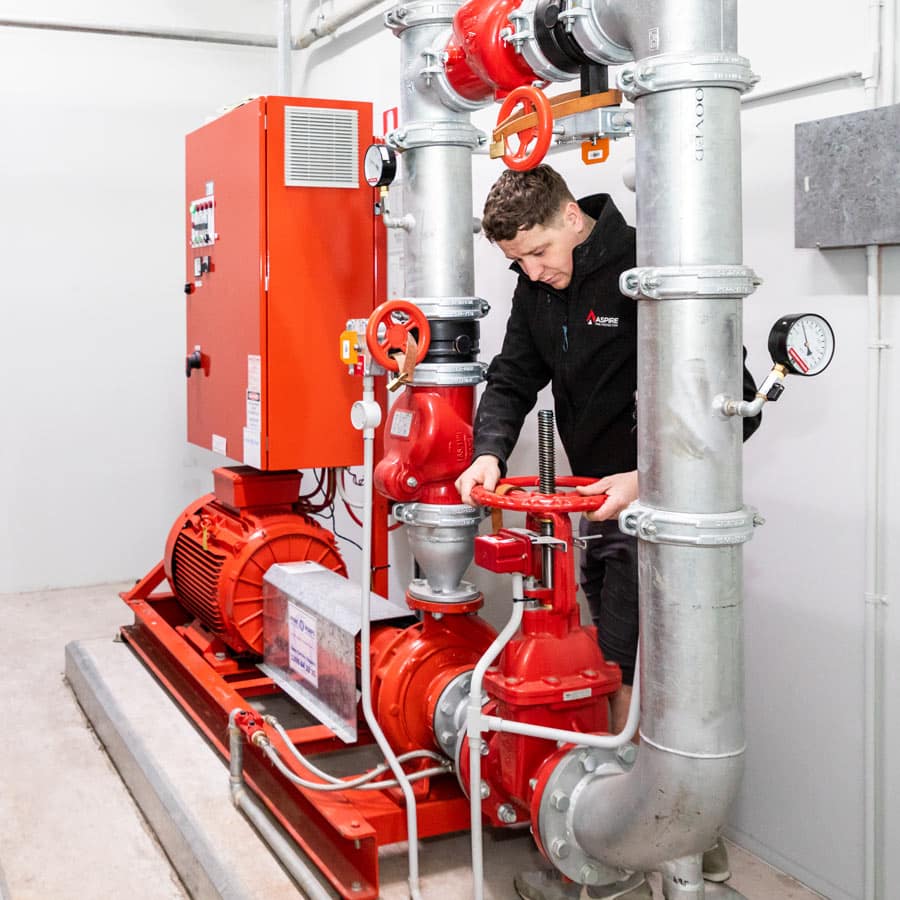
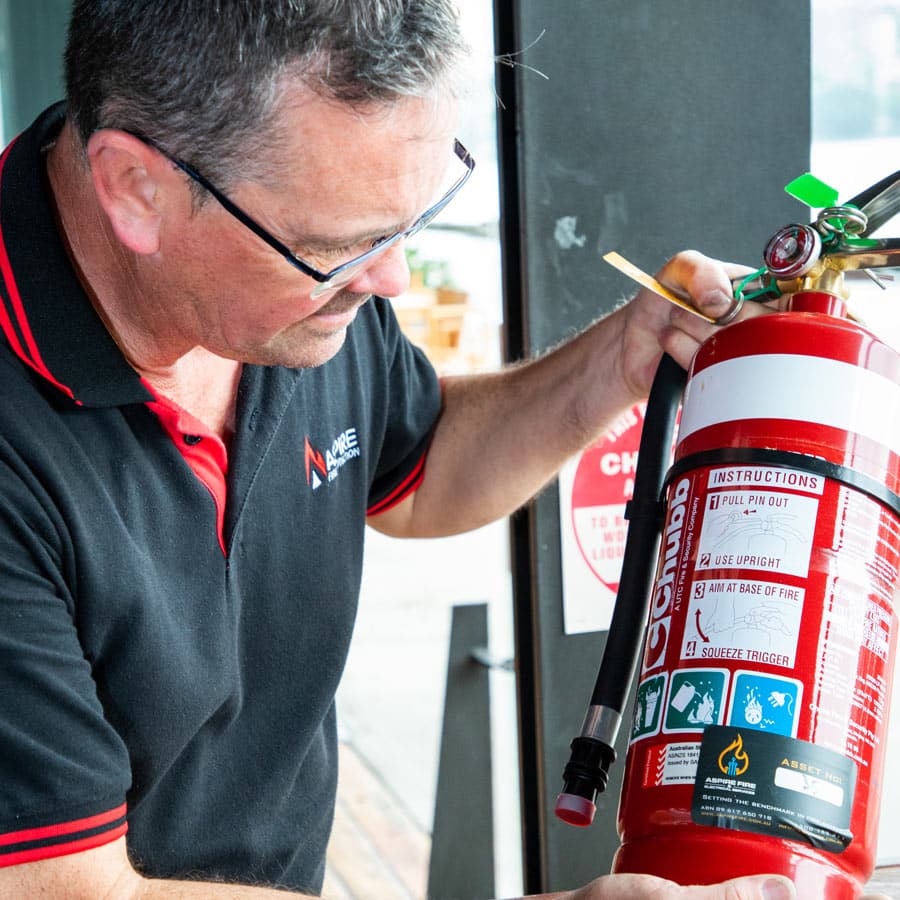
Fire Extinguishers
A Fire Extinguisher is an active fire protection device used to extinguish or control small fires, often in emergency situations.
Typically, a fire extinguisher consists of a hand held cylindrical pressure vessel containing an agent which can be discharged to extinguish a fire.
Fire extinguishers must be fitted in buildings at an easily-accessible location, such as against a wall in a high-traffic area. Legislation requires regular fire extinguisher maintenance by a competent person to ensure they operate safely.
A lack of maintenance can lead to an extinguisher not discharging when required, or rupturing when pressurised and serious accidents have occurred from corroded extinguishers exploding.
Aspire Fire can advise as to what your premises require to comply with all relevant legislation, together with the appropriate locations and signs. We can also provide training and on-going maintenance packages.
Fire Extinguisher Installation Process
SURVEY
The first step is a complete site survey to see what is needed, we can then fully meet all your requirements and make sure you are fully protected.
DESIGN & INSTALLATION
We firstly design the system to make sure all aspects are taken into account. Once this is agreed upon we will install the extinguishers with minimum disruption to you.
MAINTENANCE
Once your fire extinguishers has been installed we offer maintenance contracts which will keep your extinguishers in full working order if they’re called upon. This is an extremely important part as your fire extinguishers need to work when you need them the most.
Your Fire Extinguishers requires testing six monthly, annually and five yearly in accordance with AS1851-2012.
Upon completion of Fire Extinguishers inspections, a report is produced which gives details of the number and type of extinguisher on site, detailing the condition of the equipment and listing the areas of any non-compliance, which creates a database and asset register for future on-going inspections.
The extinguisher will have a service tag at the neck of the extinguisher showing the date of inspection and next pressure test date.
24 HOUR MAINTENANCE AND FAST RESPONSE
Assured all your concerns or issues will be dealt with as we provide a 24 hour callout facility with all service contracts.
Fire doors
Fire doors are part of a building’s passive fire protection system and are fundamental to fire strategies for buildings.
They provide critical protection within a building, such as escape routes (stairs and corridors) and separate different fire hazards in a building.
Effective fire doors ensure rooms are compartmented, to help keep fire, and possibly smoke, in the area in which it starts, to protect occupants and contents of other compartments and to protect escape routes.
A fire door consists of components that includes the door leaf, frame, seals and essential door hardware, which are referred to in the door’s fire test evidence. This is called a fire door assembly and use of the wrong components may have a significant impact on the overall performance of the fire door.
A final escape door is the door used in the event of an emergency, to exit the building and to reach a place of safety. It must operate correctly and be fitted with the correct hardware. Correct signage is also a mandatory requirement for fire doors and escape doors.
Just like fire extinguishers and alarms, fire doors and final escape doors need periodic inspection and maintenance to ensure that they will perform as intended in a fire situation.
Fire Door Installation Process
SURVEY
The first step of creating a sufficient Fire Door Plan is to do a complete site survey to see what is needed, we can then fully meet all your requirements and make sure you are fully protected.
DESIGN & INSTALLATION
We firstly design the system to make sure all aspects are taken into account. Once this is agreed upon we will install the system with minimum disruption to you. We fully test each system to make sure it’s in full working order before we finish.
MAINTENANCE
Once your Fire Doors have been installed we offer maintenance contracts which will keep your system in full working order if it is called upon. This is an extremely important part as your fire doors need to work when you need it the most.
Your Fire Doors requires testing six monthly and annually in accordance with AS1851-2012.
Upon completion of Fire Door inspections, a report is produced detailing the condition of the doors and listing the areas of any non-compliance, which creates a database and asset register for future on-going inspections.
24 HOUR MAINTENANCE AND FAST RESPONSE
Assured all your concerns or issues will be dealt with as we provide a 24 hour callout facility with all service contracts.
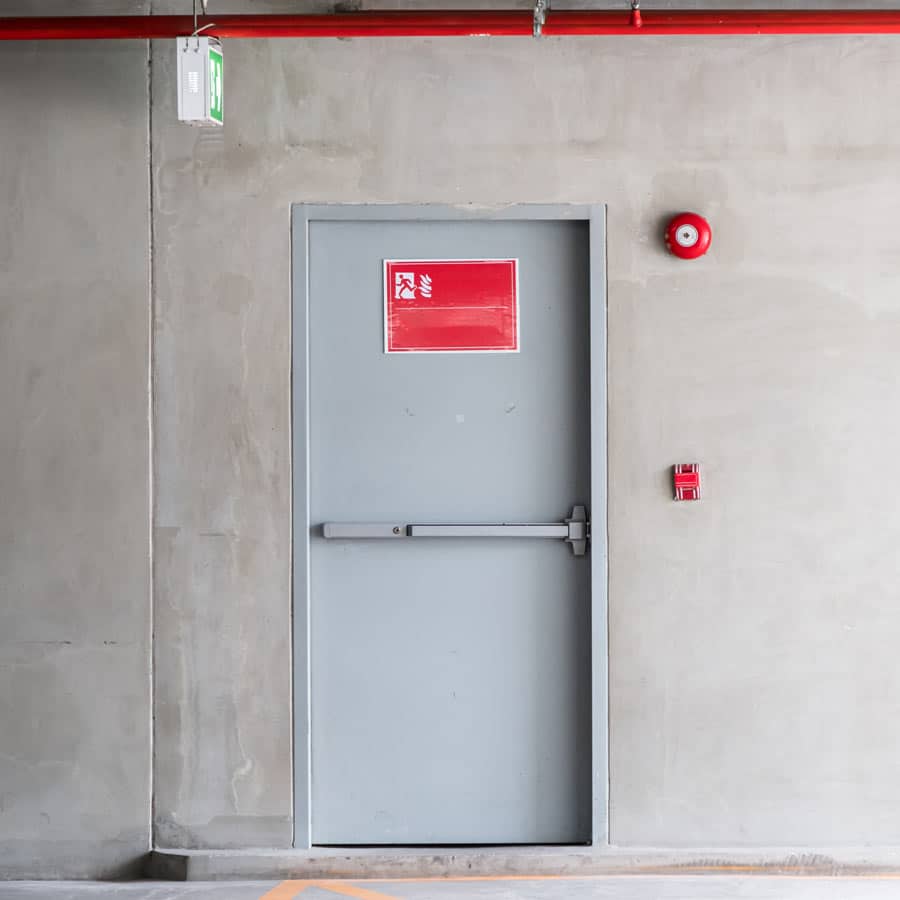
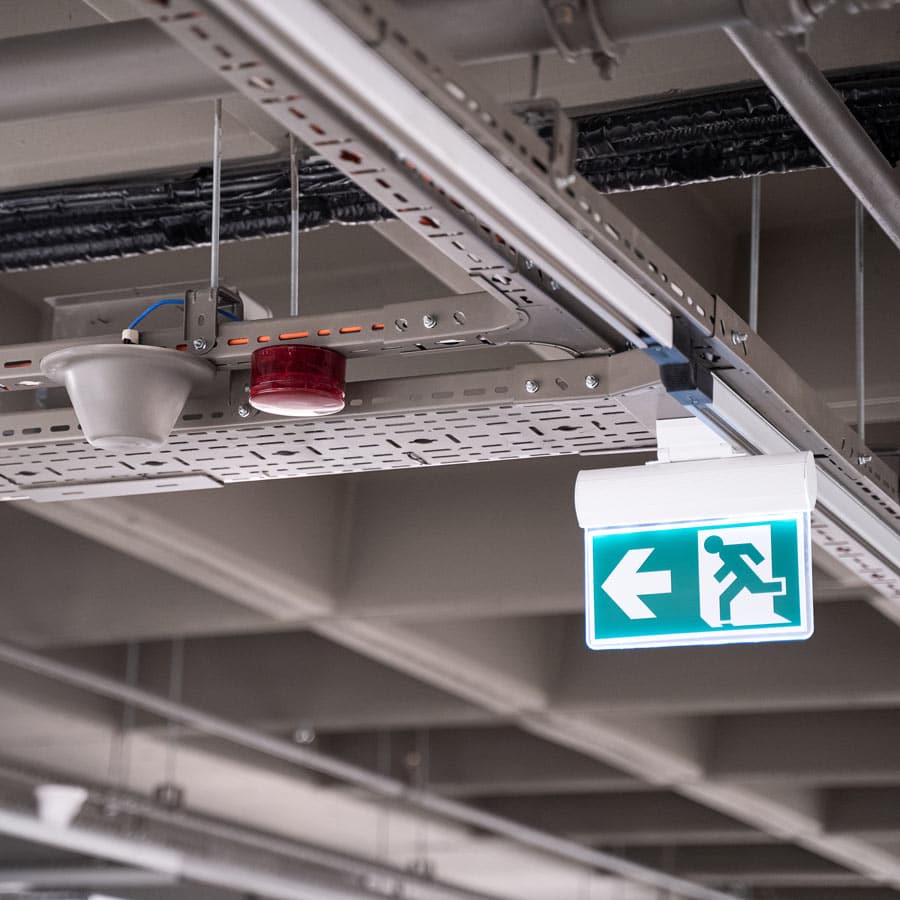
Emergency And Exit Lighting
Emergency and exit lighting is an essential fire safety measure to keep your property and people safe by ensuring a safe egress when the normal lighting fails, such as during a fire or other crisis.
Purpose of emergency lighting:
- To show clearly the escape routes and signage
- Allow safe movement without stumbling
- Help prevent panic
- Show & identify fire equipment (e.g. extinguishers)
- Permit safety operations such as locating and checking the fire control panel indications
Emergency and exit lighting must be tested, inspected and maintained in accordance with the AS 2293.2 to be completed 6 monthly. The test consists of a 90min duration test that simulates mains failure and confirms lights operation
As a licenced electrical contractor, Aspire Fire designs, installs and maintains Emergency and Exit Lighting systems.
Emergency and exit lighting Process
SURVEY
The first step is a complete site survey to see what is needed, we can then fully meet all your requirements and make sure you are fully protected.
DESIGN & INSTALLATION
We firstly design the system to make sure all aspects are taken into account. Once this is agreed upon we will install the system with minimum disruption to you. We fully test each system to make sure it’s in full working order before we finish.
MAINTENANCE
Once your Emergency & Exit Lighting has been installed we offer maintenance contracts which will keep your system in full working order if it is called upon. This is an extremely important part as your emergency and exit lighting needs to work when you need it the most.
Your Emergency and Exit Lighting requires testing six monthly and annually in accordance with AS2293.2-2005.
Upon completion of Emergency and Exit Lighting inspections, a report is produced detailing the condition of the lighting and listing the areas of any non-compliance, which creates a database and asset register for future on-going inspections.
24 HOUR MAINTENANCE AND FAST RESPONSE
Assured all your concerns or issues will be dealt with as we provide a 24 hour callout facility with all service contracts.
OWS and EWIS
Though conventional fire alarm warning systems alert occupants of a building to the presence of an emergency, they do not provide detailed information, such as evacuation routes or instructions.
Occupant Warning System (OWS) is an enhanced fire alarm alerting and evacuation control system in larger or more complex buildings. OWS system generates the standard “rising whoop” evacuation signal and plays a voice message with evacuation instructions.
It enables a Public Address (PA) message throughout the building, but does not have the same ability to divide the building into zones as an EWIS system.
In EWIS (Emergency Warning and Intercommunication System), the premises are subdivided into multiple evacuation zones instead of the whole building receiving the evacuation alerting signal simultaneously.
In response to signals from the fire alarm system, the EWIS system controls a zone-by-zone staged/phased evacuation according to a pre-programmed scheme.
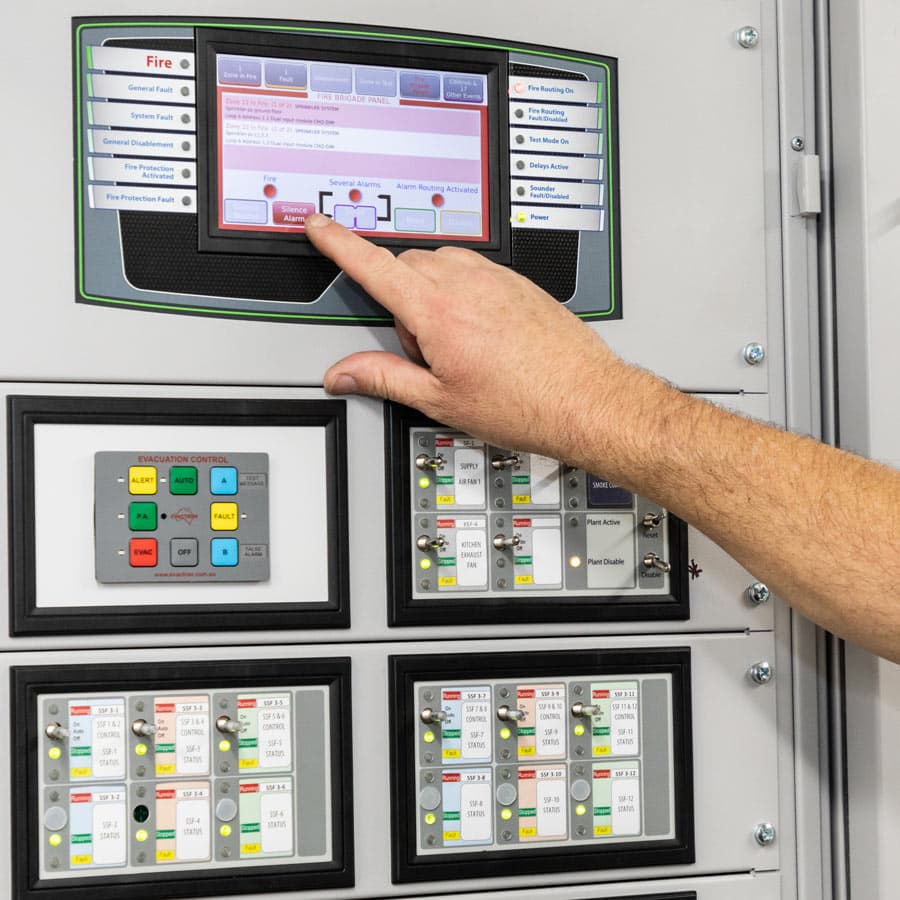
With an EWIS these messages can be customized for various types of installations, and multi-lingual capabilities are usually available. In addition, a preliminary “Alert” tone, with separate verbal message, can be played to zones that have not (yet) reached the evacuation stage. In a high-rise, for example, this would typically mobilise evacuation wardens.
A EWIS system is also designed to enable either the fire service or a designated building warden to take manual control of the evacuation, including directing Public Address (PA) messages to all or selected evacuation zones. An (optional) Emergency Intercommunication (warden telephone) system allows building wardens or fire-fighting personnel to communicate with the master evacuation control panel to coordinate evacuation efforts.
Setting the benchmark in fire safety
From installation to service Aspire Fire Protection is your one-stop fire safety provider